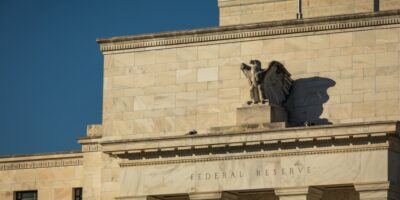Monetary Policy is Pushing Americans, Kicking and Screaming, Up the Risk Curve

The last few weeks in financial markets, particularly in equities, have been some for the books. The colossal short squeeze in GameStop (GME) followed by headhunting for shorts in a handful of other stucks was soon upstaged by a coordinated price surge of the crypto-comedic cryptocurrency Dogecoin. Its market price was pumped up from $0.007 per coin to over $.08 per coin, a surge of roughly 820% and a brief valuation of over $6 billion, although it has since fallen to between two and four cents per coin. Attention was then turned toward the pseudo-cryptocurrency Ripple (XRP), which rose from under $0.30 to $0.75 per token before sliding back down to $0.43.
While there has been an attempt to seize the narrative of exactly what is happening, prevalent explanations don’t tell the full story. A simple stock market transaction was blown up into a metaphor for class warfare (and, predictably, calls for “reform”), with grandiose allusions to small-time plungers “turning the tables” on “the big boys.” And then––of course––politicians leapt into the fray, staking out positions along the borders of their ideological frontiers.
Yet there is a far more important aspect of the meandering stock campaigns last week––which, with the failed r/wallstreetbets attempt to squeeze the silver ETF SLV, seems to be continuing––than roving packs of short interest hunters. What has fostered the growth of groups like r/wallstreetbets who’ve built a community––indeed, a prideful ethos––around taking outsized risks?
GME as Symptom
First: the risks on both sides of the GME trade were abhorrent.
On the short side, one should consider that because GameStop had traded at an average price of between $10 and $11 per share for over two years, the maximum potential gain was slightly less than that: $9 to $10 per share. And the sizing of a short position is usually assessed to a large extent upon the average daily trading volume of the stock being shorted, such that if a squeeze should begin there is a rough estimate of how difficult it will be to exit the position. With an average daily trading volume (again, over the last two years) of between four and seven million shares per day in Gamestop, one could imagine a short position of one, two, or three million shares (although other factors come into play) at most. Yet the size of the overall short position in the stock was estimated at over 60M shares: not only nearly ten times the high end of the average daily trading volume in GameStock, but thirty percent higher than the actual public float (available shares of stock).
That, to put it mildly, was a fuse just waiting to be lit.
And on the long side, retail online brokerage firms, including Robinhood, generally require $2,000 to open a margin account. Before opening the account, the suitability of the account owner must be assessed (owing to regulatory KYC, or Know Your Customer, rules). The brokerage firm is thus charged with ascertaining that active trading is appropriate for the account. This is a critical consideration in the GameStop affair for two reasons. First, despite arduous efforts to paint the long-short battle as one of David versus Goliath (respectively), the brokerage account customers had to assert, and were assessed, as having some modicum of sophistication before their accounts were open and funded.
And second, the conspiracy theories holding that Robinhood restricted trading in GameStop and other stocks, and in some cases liquidated long positions to protect its (purportedly) fellow Wall Streeters on the short side strongly indicates a deep ignorance about trading on margin and what is, quite flatly, the boilerplate standard in brokerage account paperwork.
In summation, on one side, a handful of hedge funds took massive short positions with less than $10 of upside in a thinly-traded stock which, if the trade went against them, would take many days and hundreds of dollars of upside to get out of. And on the other side, retail online brokerage customers plunging from situation to situation looking to generate short-term profit opportunities by driving up illiquid or overlooked issues: in margin accounts, with between little and no understanding either of the risks they faced. Or, worse yet, of the actions that brokerage firms, clearing firms, or intermarket dealers can take to mitigate their own risk.
Both groups – the hedge funders and the small-time hobbyists are, of course, well within their rights to explore profit opportunities with constraints (for the short-selling hedge fund, parameters set by its operating agreement, investors, and backers; for the retail online traders, the risk parameters set by the brokerage and its execution partners). And this goes beyond GME, AMC, Dogecoin, SLV, and other recent campaigns.
Risk tolerance over time
In fact, risk tolerances are up across the board. There are anecdotes, of course, but the evidence is clear in trends of some of the most historically risky markets. The stock market, once a fairly mid-range option for risk and return, has gone from a complement to a substitute for the role that bank accounts or Treasury bonds once filled.
Historically, a number of investments have resided at the riskier end of the asset spectrum, and in recent years have been growing in ownership and popularity. Without touching on options and futures (which are not really “investments”), and other, more exotic financial products (such as DPPs), they include the following.
Microcap stocks
Investors have clearly become more interested in the riskiest segment of the equities markets. A look at the Russell Microcap Index shows this. In the roughly five years between 1 January 2015 and the market crash on 16 March 2020, the total return on two major microcap stock indices (OTCQB and Russell Microcap Index) versus the S&P 500, Dow Jones Industrial Average, and Nasdaq Composite were as follows; note the comparative total returns and annual equivalent rates:
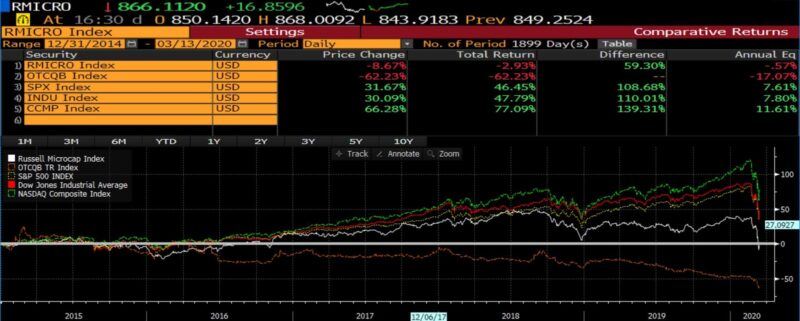
And yet, since the March 2020 crash, comparative returns have shifted markedly; again note the change in total returns and annual equivalent rates:
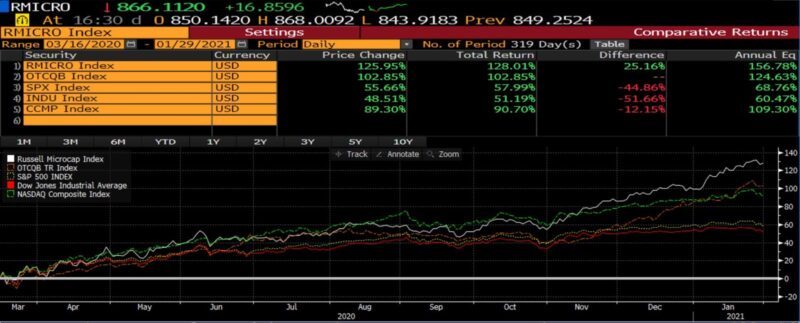
In the five years wherein the Fed began to slowly raise rate targets, large cap stocks did fairly well while microcaps largely fell. And since the Fed tanked rates back down in the early portion of the pandemic, the smallest and most speculative segment of equities has returned double what large, established publicly-traded companies have.
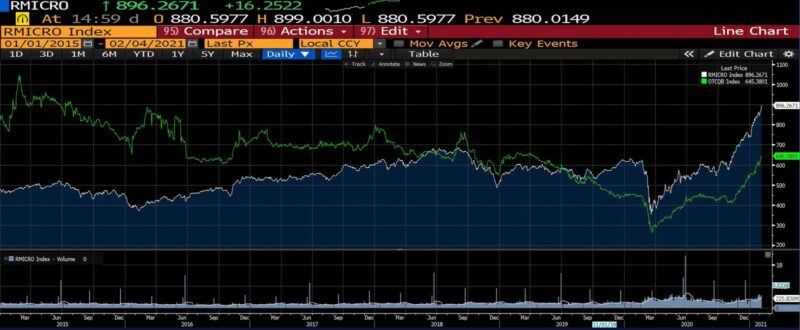
As shown: in the wake of the tremendously expansionary turn in monetary policy in March 2020, microcap stocks rocketed upward in price.
Leveraged, inverse, and thematic ETFs
The number of ETFs (exchange-traded funds) has grown from less than 400 in 2006 to just under 7,000 at present. Many are illiquid and only suitable for long-term investment. The increasing risk appetite among investors and traders has been met by the addition of several particularly risky types of ETFs: leveraged (which offer a multiple of returns over a set time period by employing derivatives), inverse (which return the opposite of what a given sector or market does), and thematic (where the assets in the fund are tied to a particular investment idea or trend). Thematic ETFs, despite receiving one of every three dollars directed into U.S. equity ETFs in January 2021, have actually lost as much as 5% per year for the past two decades on a risk-adjusted basis. Nevertheless, they now account for $142 billion in assets. A large amount of the inflow of assets of late has been into funds focusing on environmental, social, and corporate governance investments (ESG).
IPOs and the SPAC craze
Many financial analysts have likened the recent spike in initial public offerings (IPOs) to the 1999 boom which, then as now, points directly at investors’ desire to capture new issues with the largest short-term growth potential. A handful of companies which have gone public in the conventional way––via syndication and underwriting departments at investment banks––have seen initial price surges bringing to mind the loftiest heights of the dot-com era. On the first day of trading, for example, Airbnb jumped 112% above its offering price, DoorDash 86% (despite some analyst disparagement), and Pop Mart International 79%.
A look at the Renaissance IPO index starting in 2010 highlights the speculative fervor, particularly since the March 2020 stock market crash and the series of Fed liquidity infusions:
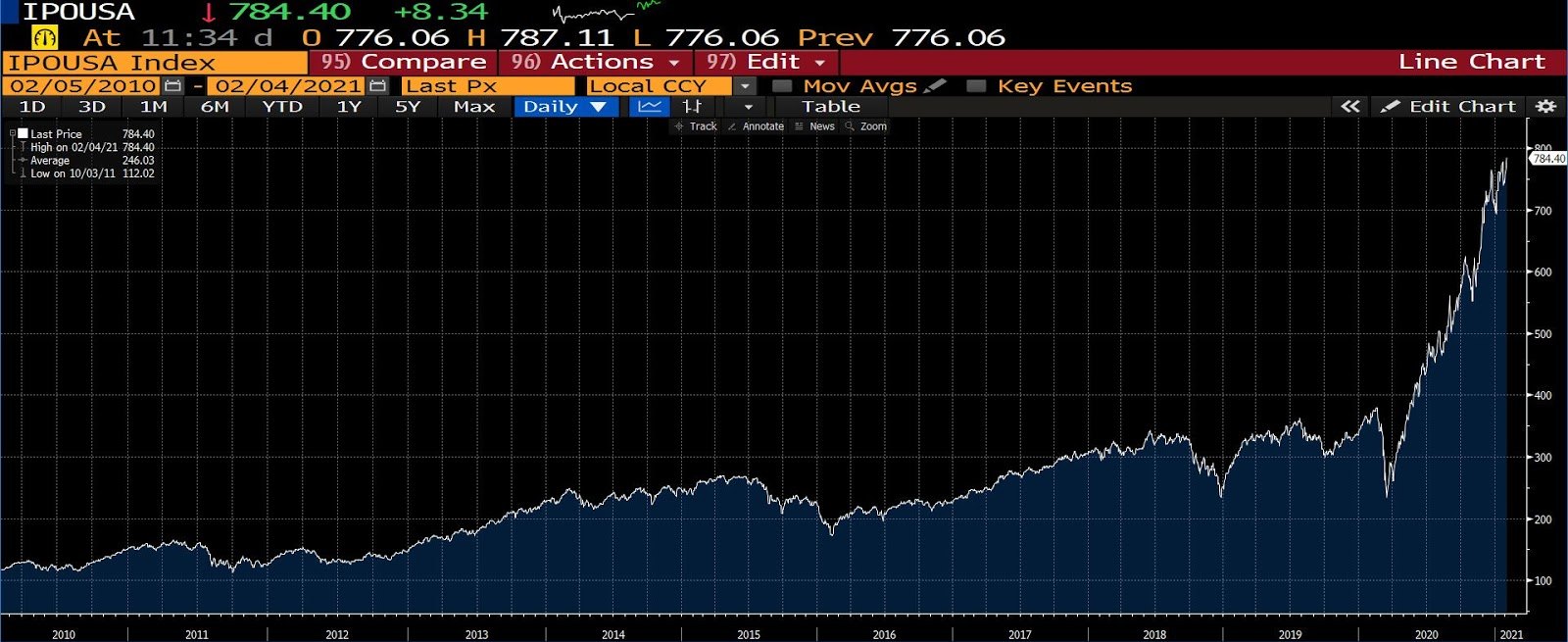
The number of IPOs in 2020––over 400, compared to 195 in 2019, 214 in 2018, and 176 in 2017––exhibits a two-way causality with risk appetites. As markets rise, buoyed by asset price inflation and investors jumping atop the bandwagon, companies undertake IPOs to catch the gains associated with higher valuations. And as companies undertake IPOs, investors seek them out for their appreciation potential. But setting aside that the immediate post-issuance price jumps are a clear indication of investor hunger for the outsized returns that new issues often bring, they’re also a tremendous misfire for the stock-issuing company. The price exploding upward on the day of the IPO suggests a profound underpricing of the issue, leaving many millions of dollars “on the table.”
Related to this is the Special Purpose Acquisition Company (SPAC) craze. Once an obscure method of financing firms, there has been an explosion of SPAC offerings. In 2019, SPACs raised roughly $19 billion. They raised over $76 billion in 2020, and over $15 billion in the first few weeks of 2021.
Although there are solid reasons as to why a firm might eschew the standard IPO process (working through an investment bank) or why investors might finance a firm directly, SPACs fundamentally represent a new degree of risk seeking. They are essentially “blank check” companies, shells into which both retail and institutional investors can participate in transactions which replicate the functions of private equity. Some, to be sure, are managed by financial institutions and involve professional business managers. But the meteoric rise in SPAC popularity is reminiscent of the “blind pools”––investments where managers are given extraordinary discretion––of other hyper-speculative eras. In any event, that uptick represents money thrown into financial markets in search of an idea.
No doubt many firms will have successful SPAC lives, characterized by commercial innovation and, over time, enriched investors. Others will assuredly fail. A look at the IPOX SPAC Index shows an ebullient trend indeed…but was established in August 2020, only six months ago.
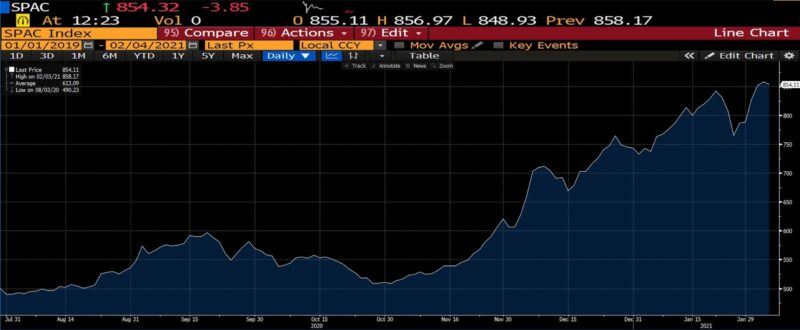
None of this rapidly burgeoning craving for risk would surprise the Federal Open Market Committee. One year ago, with the rate target at 1.50% to 1.75%, CNBC reported that in the minutes of their December 11th 2020 meeting,
[a] few participants raised the concern that keeping interest rates low over a long period might encourage excessive risk-taking, which could exacerbate imbalances in the financial sector…[and that low rates] could make the next recession more severe than [it might] otherwise [be.]
Nevertheless, only four of the 17 voting members indicated support for a rate hike during 2020. As we now know, rates would be back in ZIRP territory within three months, and the brief attempt to restore historical normalcy in rates, the assessment of risk and return, and innumerable other financial considerations were knocked back to the proverbial square one:
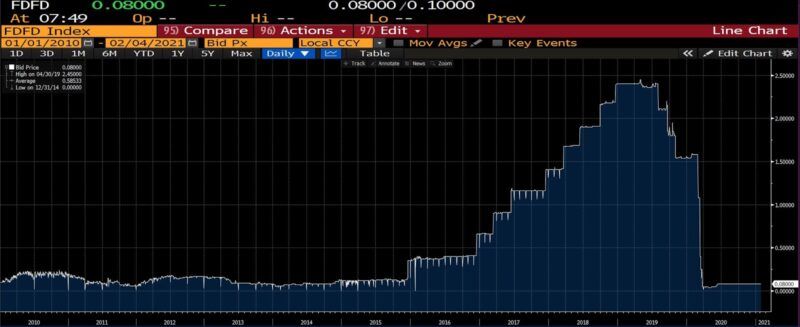
The breakneck pace of return-chasing is even less surprising in light of recent trends of what were, for decades, traditional avenues for risk-averse savers and investors. Virtually all of the historically-reliable investment options have experienced collapsing returns amid sequential bouts of monetary easing programs, forcing investors into inevitably riskier financial vehicles. A few, with a look at their recent performance, follow.
Certificates of Deposit
A certificate of deposit (CD) is a traditional bank or credit union offering which is essentially a defined lump-sum deposit. If left untouched for a discrete period of time, it pays a premium over the savings and checking account rate of interest. Of course, actions of the Federal Reserve (and specifically the decisions of the Federal Open Market Committee) bear directly upon the financial products and terms offered by financial institutions. Below is the trend in six-month CD yields since 1990.
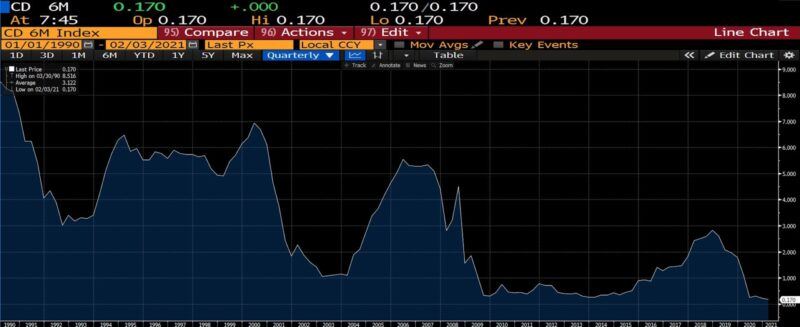
10-year U.S. Treasury bonds
For most of the 20th century, U.S. Treasury bonds were the standard––indeed, the default used in financial models––of risk-free instruments. Liquid and with guaranteed principal and interest, laddered (meaning structured across maturities and payment dates) U.S. government obligations were a standard portfolio for reliable income and moderate return with low volatility. But campaign after campaign of dovish monetary policy initiatives have pushed Treasury yields down to once-inconceivable lows. Here is the 30-year trend in 10-year Treasury yields.
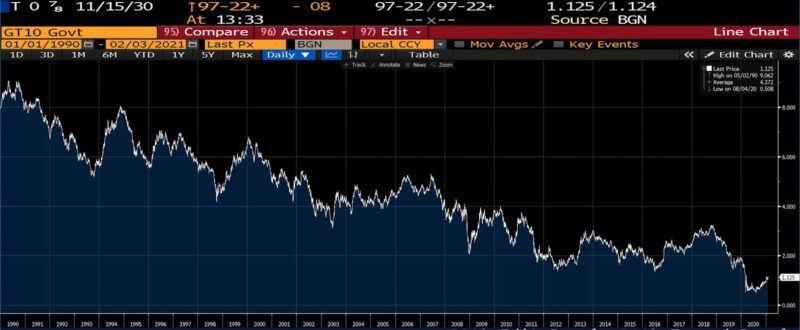
Traditionally the 10-year Treasury yield has been higher than the S&P 500 dividend yield. Note, in the bottom section of the graph, the long periods of red (periods of time where the 10-year Treasury paid higher interest than the dividend yield on the S&P 500 index) with very short periods of green where the S&P 500 dividend yield briefly rose above the 10-year Treasury yield (for example, during financial crises, such as in 2008, or periods of changing policy). It happened very infrequently, and rarely by an appreciable amount (1.00% or less).
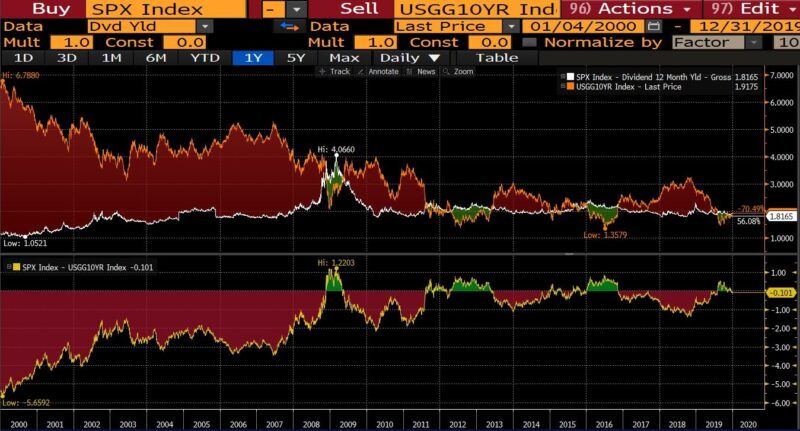
Yet since March 2020, the spread has flipped to historically anomalous levels (all “green,” indicating the S&P 500 dividend yield was vastly higher than the 10-year Treasury yield):
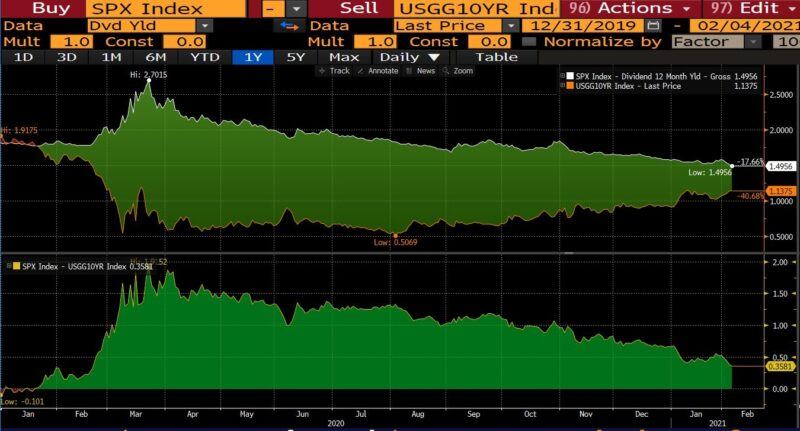
The very idea that in July 2020 the dividend yield on a total stock market index fund (roughly 1.80%) was nearly three times the yield on a 10-year US Treasury note (then 0.66%) and almost half of one percent higher than a 30-year U.S. Treasury bond (then 1.40%) shows, clearly, the effect of the tidal wave of the easiest money in history. It also, looking at the progression of both of the spread charts, starkly displays how investors who could once transition from higher-risk investments (stocks) into principal-protected, income-oriented lower risk investments (government bonds) now face a dire financial choice: assume more risk, or persist amid lower, arguably negligible, inflation-consumed returns.
Municipal bonds
Highly-rated municipal bonds were long favored by investors owing to their yields (they often pay several hundred basis points or more above U.S. Treasuries of comparable maturity) and their exemption from certain taxes. But they, too, have seen their yields collapse over the last few decades. Here is the Bond Buyer 20-Bond General Obligation index since 1990; it tracks the weekly average yields of municipal obligations with 2-year maturities having S&P ratings of AA and above.
These are some of the safest of the munis, and like the other typical safe havens for risk-averse investors, the frequent undertaking of expansionary monetary policy has pushed yields on these bonds toward zero.
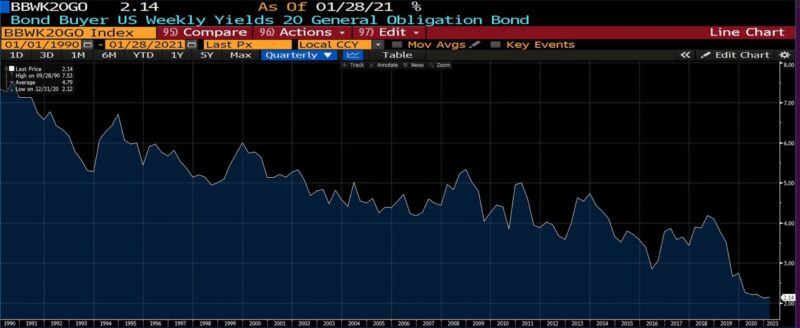
Conclusion
The recent drama financial markets have seen, whether it concerns GameStop, Dogecoin, or another object of the r/wallstreetbets community’s affection, turned heads and raised eyebrows. A narrative quickly emerged, one in which the goliaths of Wall Street were toppled by the scrappy Main Street retail traders and their small-but-determined financial slingshots. Though romantic, these last few weeks are in reality far more indicative of Americans’ ballooning tolerance for financial risk. Faced with the possibility of significant returns––perhaps of too-good-to-be-true proportions––both short sellers and short interest hunters surrendered their inhibitions and took questionable gambles.
And though this situation is simpler than the grandiose Main Street vs. Wall Street framing, it is simultaneously more complex than the notion that amateur traders were simply looking to make a quick and easy buck––or that a handful of hedge funds took a tremendously risky bet ensconced only in hubris. What is regularly dismissed as greed may be more appropriately framed as desperation, in many cases. Where investing in the stock market was once a companion to engaging with less-risky bank accounts or Treasury bonds, today’s investors have by necessity become more willing to play their hand in more precarious quarters. Risk appetites broadly have been driven up artificially. The r/wallstreetbets chaos is far from an anomaly in terms of current investment preferences––it’s a symptom.
The Federal Reserve has done more in the past 25 years than its founding legislators and early governors surely ever conceived it would. With that in mind, one wonders what the end game is, especially in light of two facts. First, that the inclination of monetary authorities the world over is toward lower and lower thresholds for intervention. And second, that fiscal and monetary policies have a way of suddenly finding limits when the tax-paying everyman is on the receiving end. If there is a component of the growing disposition for risk inspired by the idea that the Fed will swoop in to save retail investors from failed ETFs, collapsed SPAC prices, a wave of microcap stock delistings, or any other consequence of their understandable but reluctant march up the risk curve, it is ill-advised. Any lasting solution is far more likely to come from markets themselves.


